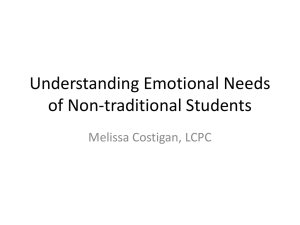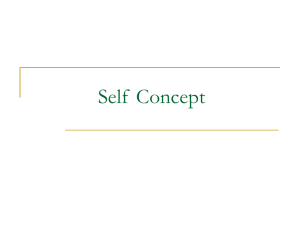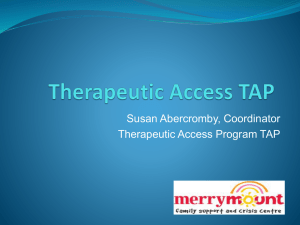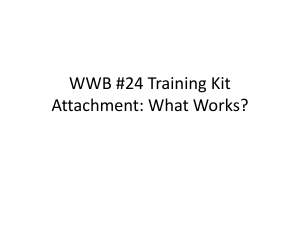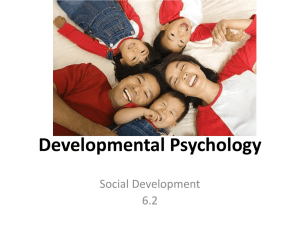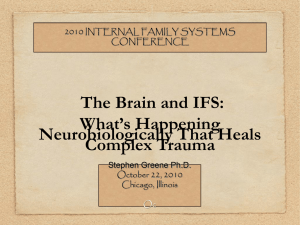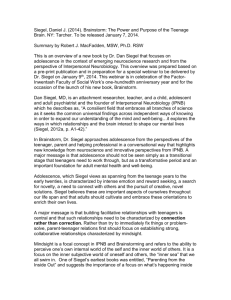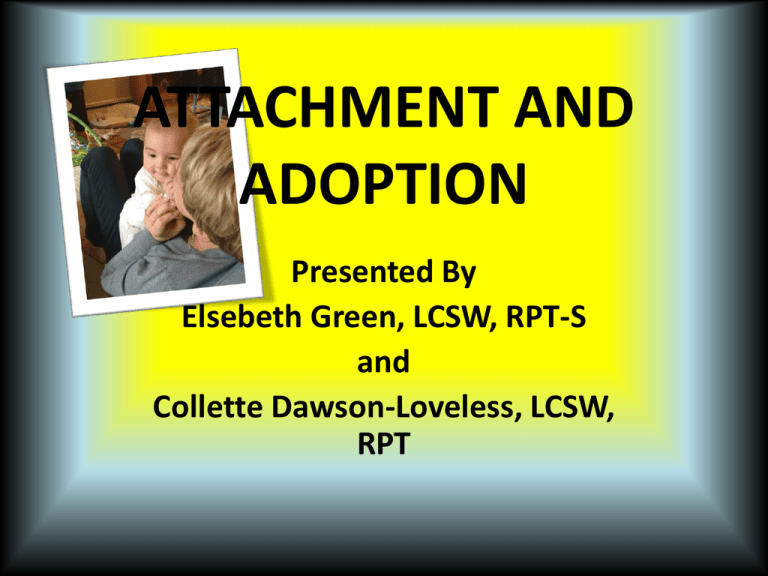
ATTACHMENT AND
ADOPTION
Presented By
Elsebeth Green, LCSW, RPT-S
and
Collette Dawson-Loveless, LCSW,
RPT
Attachment
Arousal/Relaxation Cycle
Dr. Vera Fahlberg, Separation and Attachment, 1979
Needs
safety
belonging
esteem
PROXIMITY
Relaxation
Arousal
Need Met
(By caregiver)
Regulation of Nervous System
Brain = Central Nervous
System and entire body
Particularly the nerve
bundles surrounding the
heart and gut
Optimal brain activity =
optimal bodily arousal
Healthy, Calm Brain =
Healthy Physiological
Functioning
The Neurobiology of Attachment
Attachment dynamics impact the following areas of
brain development:
– Neurochemical activity
– Size/development of brain tissue
– Emotional Regulation
– Regulation of the nervous system
– Concepts about self/others/the world
– Memory
The development of language
Ability to assume the view point of another
The development of trust and positive world
view
The development of self-esteem
Anxiety reduction and sense of security
Love of physical touch and intimacy
Learning through social interactions
Ability to play and share mutual enjoyment
Healthy, brief shame as vehicle for
socialization
Self-reliance and reliance on others
Organized meaningful emotion
Intersubjectivity
Primary Intersubjectivity
The infant and parents’ exploration
of
and discovery of each other and self
in relation to the other is two-fold:
1. Eyes, voice, gestures and touch of father
and mother to the infant (I’m special,
interesting, lovable to my parent)
2. Eyes, voice, gestures and touch of infant to
parent (I’m a good parent)
Trevarthen, 2001, Trevarthen & Aiken 2001
Secondary Intersubjectivity
An infant’s discovery of the
features of the world
(people, objects and
events) through the impact
of the world on themselves
and their parents:
1. meaning
2. template for relating
to others and the world
3. person-to-person-toobject relationships are
established
Mindsight
When things go wrong
ATTACHMENT CYCLE - Anxious
--A
New Need Triggered:
SAFETY, BELONGING, ESTEEM
– ESPECIALLY BELONGING
Achieved: decreased sense of
SAFETY, BELONGING, ESTEEM AS
Parent feels they are failing and
child fears getting sent away
DISTRUST
Outcome: more dysregulation,
escalating all reactions and
behaviors (in your face) or storming
off in hopes you will follow, parent
happy to have break. Sees
consequences as hate.
Personal reactions: Intense
Emotions, bodily sensations,
implicit/explicit memories of
abandonment
Learned Behaviors follow:
tends to be clingy, whiney, angry,
push-pull, chatty, emotional,
insistant, lying, stealing
Attachment figure responds:
frustration sets in as child continues to
act in similar ways, never satisfied,
seldom grateful, angry exhausted eyes
ATTACHMENT CYCLE- Avoidant
New Need Triggered:
SAFETY, BELONGING,
ESTEEM BUT USUALLY
SAFETY OR ESTEEM
Achieved: decreased sense of
SAFETY, BELONGING, ESTEEM as
child plans to run, dig their heals in
and refuse to feel or comply, and
parent feels they are failing and
really don’t like this child.
Personal reactions:
Emotions,(mostly just anger) bodily
sensations (wants to run away), implicit
memories (feels that nothing affected
them and yet can’t really remember
much)
DISTRUST Learned Behaviors follow:
Outcome: dysregulation increases as
child shuts down or challenges parent’s
right to tell them what to do. If child
complies, a sense of hate permeates.
Sees consequences as hate
often pushes others away, goes
away, shows bravado or
narcissistic traits, controlling,
sneaky behaviors, lying, stealing
Attachment figure responds:
punishing, demanding to know why,
wanting to “humble”/”control” child,
angry eyes, tightening structure and
control
ATTACHMENT CYCLE - Disorganized
New Need Triggered:
SAFETY, BELONGING, ESTEEM
Achieved: decreased sense of SAFETY,
Personal reactions:
BELONGING, ESTEEM as child sees self as
bad, crazy, disappointing and parent is
bewildered and repulsed
Emotions, bodily sensations,
implicit and explicit memories
flood in and child melts down
DISTRUST
Outcome: complete dysregulation until it NO Learned Behaviors follow:
just stops on its own or help is called in.
Child has no abiltiy to discuss or process;
no concept of consequences. Parent feels
like a failure or the child is beyond repair
Toolbox does not exist in any
organized way. Often bizarre
regressed behaviors including
encopresis and hurting others
Attachment figure responds:
confused and awkward efforts to
see and respond to the child’s inner
self in this animal like presentation.
STYLES OF ATTACHMENT
• SECURE – SENSE OF SAFETY,
BELONGING AND ESTEEM 55%
• ANXIOUS- FEAR OF REJECTION 15%
• AVOIDANT – FEAR OF BEING
TRAPPED 20%
• DISORGANIZED – DEEPLY
WOUNDED WITH NO DISCERNABLE
PATTERN OF RELATING 5%
DSMV Diagnosis we commonly use:
• 309.81 -Post-traumatic Stress Disorder –recurrent, involuntary, and
intrusive distressing memories of exposure to actual or threatened death, serious
injury, or sexual violence. Intense or prolonged psychological distress at exposure
to internal or external cues that symbolize or resemble an aspect of the traumatic
event.
•
•
•
•
•
•
995.54 Child Abuse – Confirmed
995.53 Child Sexual Abuse - Confirmed
995.52 Child Neglect – Confirmed
995.51 Child Psychological Abuse, Confirmed
V61.20 Parent-child relational problem
313.89 Reactive Attachment Disorder -Consistent pattern of
withdrawn behavior, not seeking, not accepting comfort; minimal social
engagement
• 313.89 Disinhibited Social Engagement Disorder - overly familiar
verbal and physical behavior with unfamiliar adult with diminished or
absent checking back with main caregiver
Traits of Severely Attachment
Disordered Children
•
•
•
•
•
•
•
•
Angry and controlling
Mean and hurtful
Affectionate/charming when it suits them
Lie and steal
Create conflict between others to divide them
See others as objects to be manipulated
“Play” with behavior plans to get what they want
People seem to mean nothing to them except as vehicles to
get needs met; servants; do not miss them or feel “love”
• Hurt animals and younger children
• Put up huge resistance to limit setting or consequences
• Self soothe in various inappropriate ways
Discovering your own style . . .
• What is your own attachment style
PAST
Background
Relationships
Separation
Discipline
Fear/Threat
Loss
Emotional Communication
Safe Harbor (Secure Base)
Launching Pad (Safe Haven)
PRESENT
FUTURE
ESTABLISHING PACE
Daniel Hughes
• Playfulness
• Acceptance
• Curiosity
• Empathy
Principals of Treatment
1. Eye contact, voice tone, touch, movement and
gestures are only to communicate safety,
acceptance, curiosity, playfulness and empathy
and are only reciprocal – never coerced.
2. Opportunities for enjoyment and laughter, play
and fun, are provided daily and unconditionally.
3. Decisions are made for the purpose of providing
success not failures.
4. Successes become the basis for the
development of age-appropriate skills.
5.
The child’s symptoms or problems are accepted and contained. The
child is shown how these simply reflect his history. They are often
associated with shame which must be reduced by the adult’s
response to the behavior.
6. The child’s resistance to parenting and treatment interventions is
responded to with acceptance, curiosity and empathy.
7. Skills are developed in a patient manner, accepting and celebrating
“baby-steps” as well as developmental plateaus.
8. The adult’s emotional self-regulation abilities must serve as a model
for the child.
9. The child needs to be able to make sense of his/her history and
current functioning. The understood reasons are not excuses, but
rather they are realities necessary to understand the developing self
and current struggles.
10. The adults must constantly strive to have empathy for the child and
to never forget that, given his/her history, s/he is doing the best s/he
can.
11. The child’s avoidance and controlling
behaviors are survival skills developed under
conditions of overwhelming trauma. They will
decrease as a sense of safety increases, and while
they may need to be addressed, this is not done
with anger, withdrawal of love, or shame.
Experience with States
• Feel Better with Just one Word YouTube
Resource List
• Building the Bonds of Attachment, Daniel Hughes
• Brainstorm: The Power and Purpose of the Teenage Brain, Daniel J.
Siegel
• The Whole-Brain Child, Daniel J. Siegel
• Love Sense: The Revolutionary New Science of Romantic
Relationships, Sue Johnson
• Brain-Based Parenting, Daniel Hughes and Jonathan Baylin
• Parenting the Hurt Child, Keck and Kupecky
• The Neurobiology of We, Daniel J. Siegel
• Mindsight, Daniel J. Siegel
• Removed, http://vimeo.com/73172036
• Feel Better with Just One Word,
https://www.youtube.com/watch?v=0E82oV_BeLo


